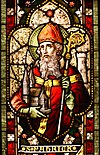Andrew the Scot
Saint Andrew the Scot | |
|---|---|
| Born | 800s |
| Died | c. 877 Fiesole, Italy |
| Venerated in | Roman Catholicism, Eastern Orthodoxy |
| Major shrine | Saint Martin, Fiesole, Italy |
| Feast | 22 August |
| Attributes | deacon curing a paralytic girl; sometimes shown appearing to a sleeping priest; Irish wolfhound |
St. Andrew the Scot was the brother of St. Brigid the younger, born in Ireland near the beginning of the ninth century to a noble family. Both Andrew and his sister studied under St. Donatus. Andrew even accompanied Donatus on his pilgrimage to Italy and there Andrew earned his titles (in Britain) of Andrew of Tuscany and Andrew of Fiesole.[1]
When Donatus and Andrew arrived at Fiesole the people were assembled to elect a new bishop. A heavenly voice indicated Donatus as most worthy of the honour. After being consecrated to that office, he made Andrew his archdeacon.
There is a miracle reported of his healing the daughter of a nobleman while he was in Fiesole. The girl had been paralyzed and the doctors were unable to help her so their father asked Andrew to come and pray for her. Kneeling by her couch he told her to stand for Jesus had healed her. Many other miracles were performed by him over the course of his deaconship in Fiesole: casting out demons, healing the blind, and the sick.[2]
During the forty-seven years of his episcopate, Andrew served Donatus faithfully, and was encouraged to restore the church of San Martino di Mensola and to found a monastery there. Andrew is commended for his austerity of life and boundless charity to the poor. He died shortly after his master, St. Donatus. His sister was allegedly conducted from Ireland by an angel to assist at his deathbed.
His body is buried at St Martin's, the church he restored. When at a later date his remains were exhumed, his body was found still preserved. His relics remain to be venerated in that church.[3]
St. Andrew's feast day is on the 22 of August.
References
- ^ Thurston, Herbert. "St. Andrew the Scot." The Catholic Encyclopedia. Vol. 1. New York: Robert Appleton Company, 1907. 25 Dec. 2012
- ^ Lives Of The Irish Saints (O'Hanlon)
- ^ Lives Of The Irish Saints (O'Hanlon)
Sources
 This article incorporates text from a publication now in the public domain: Thurston, Herbert (1907). "St. Andrew the Scot". In Herbermann, Charles (ed.). Catholic Encyclopedia. Vol. 1. New York: Robert Appleton Company.
This article incorporates text from a publication now in the public domain: Thurston, Herbert (1907). "St. Andrew the Scot". In Herbermann, Charles (ed.). Catholic Encyclopedia. Vol. 1. New York: Robert Appleton Company.- Saint of the Day, August 22: Andrew of Fiesole at SaintPatrickDC.org

